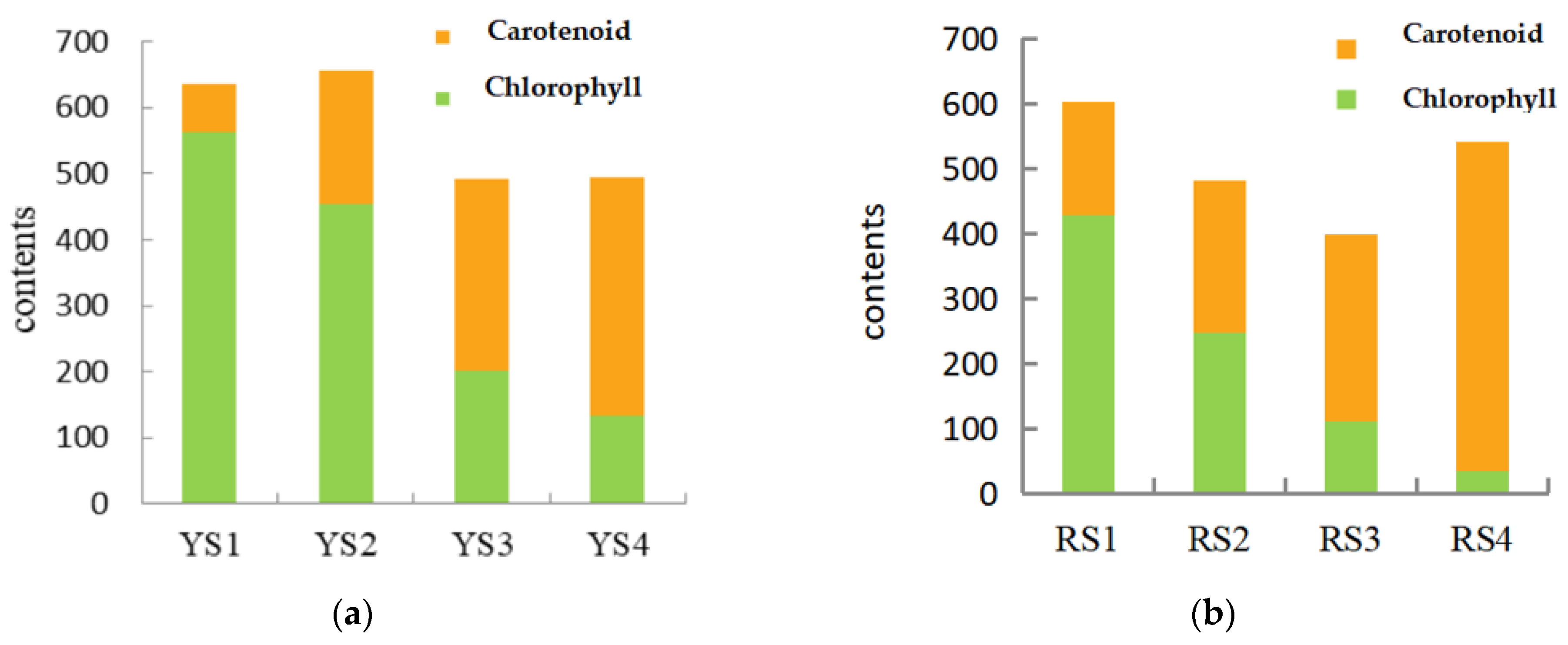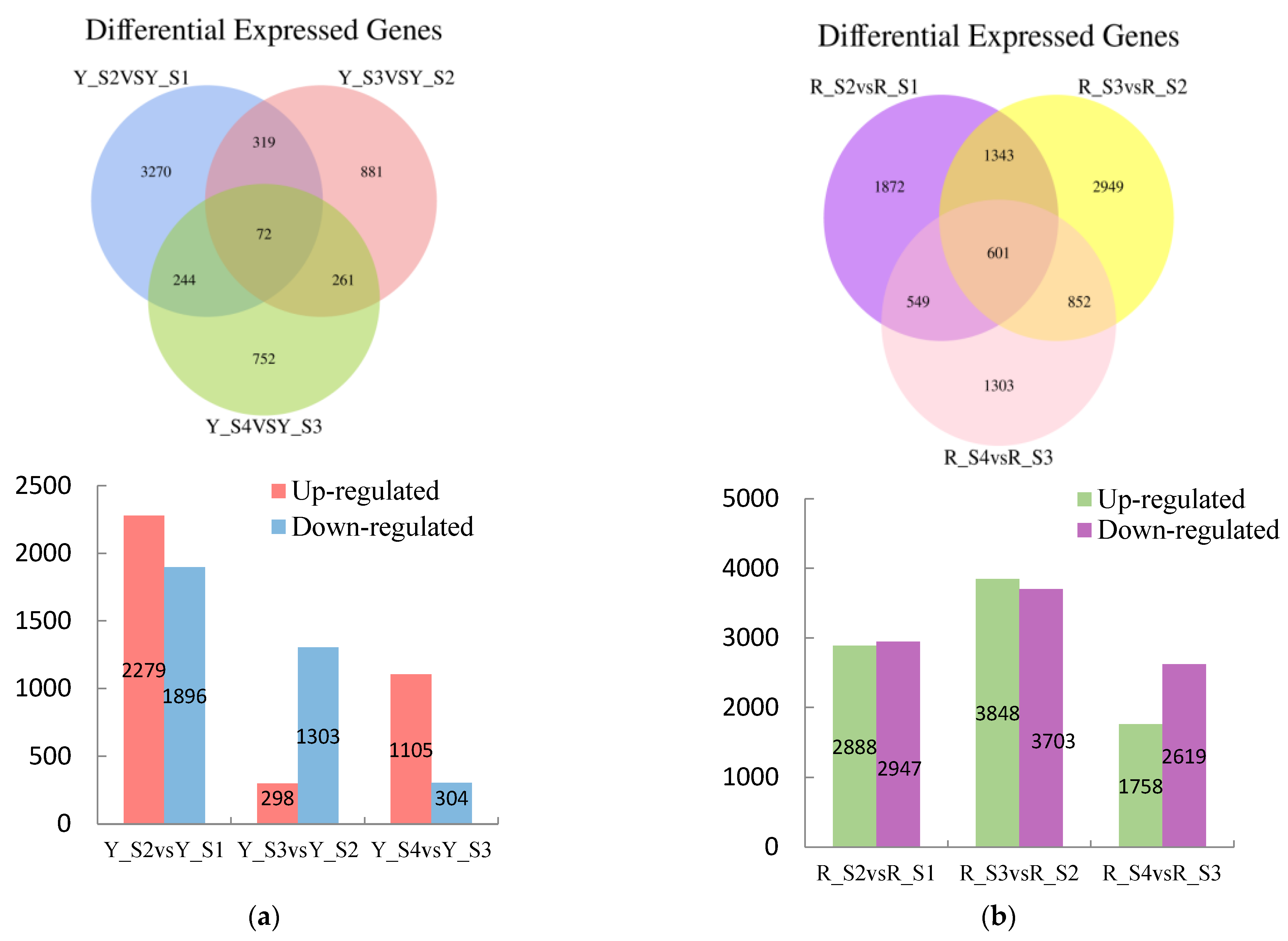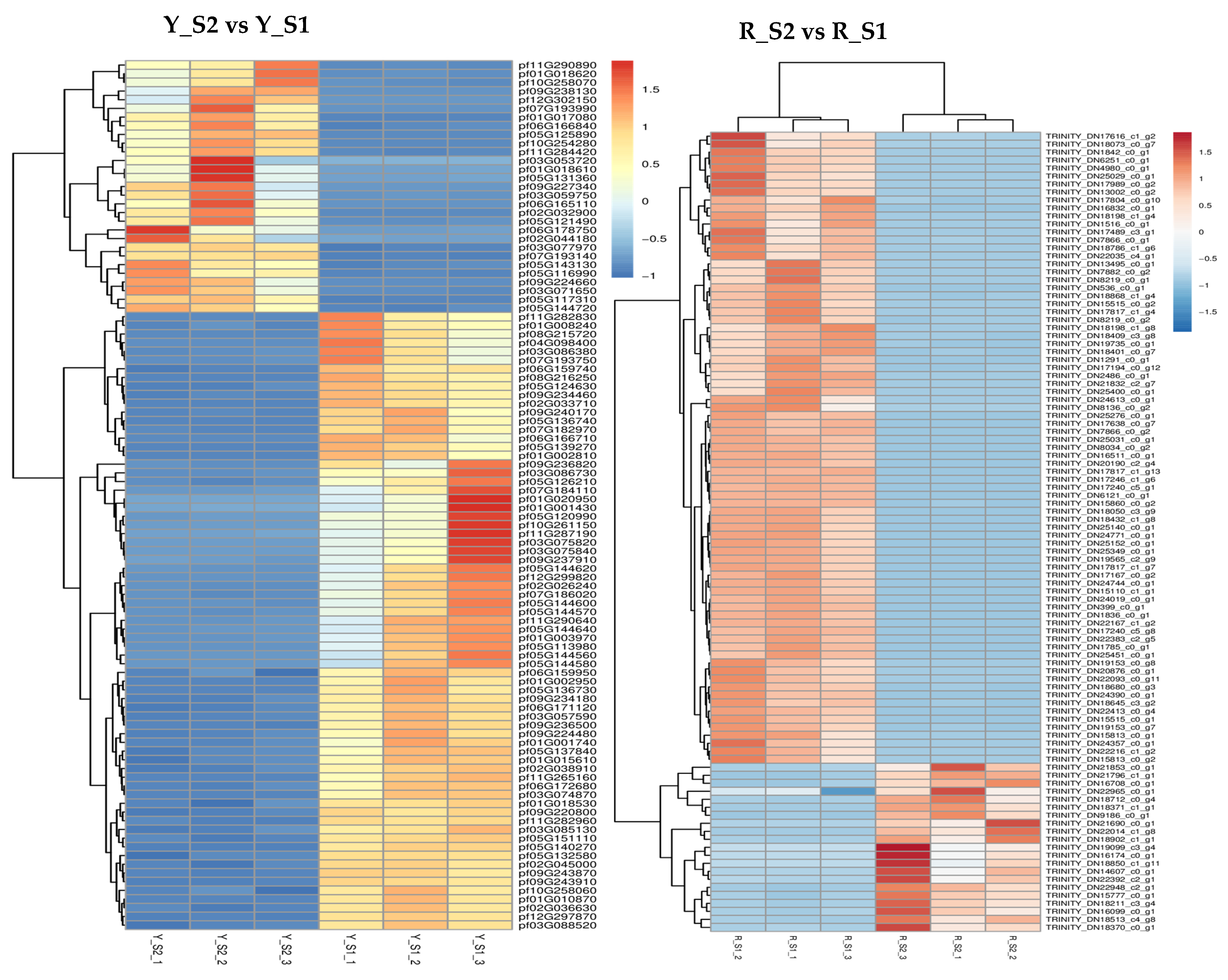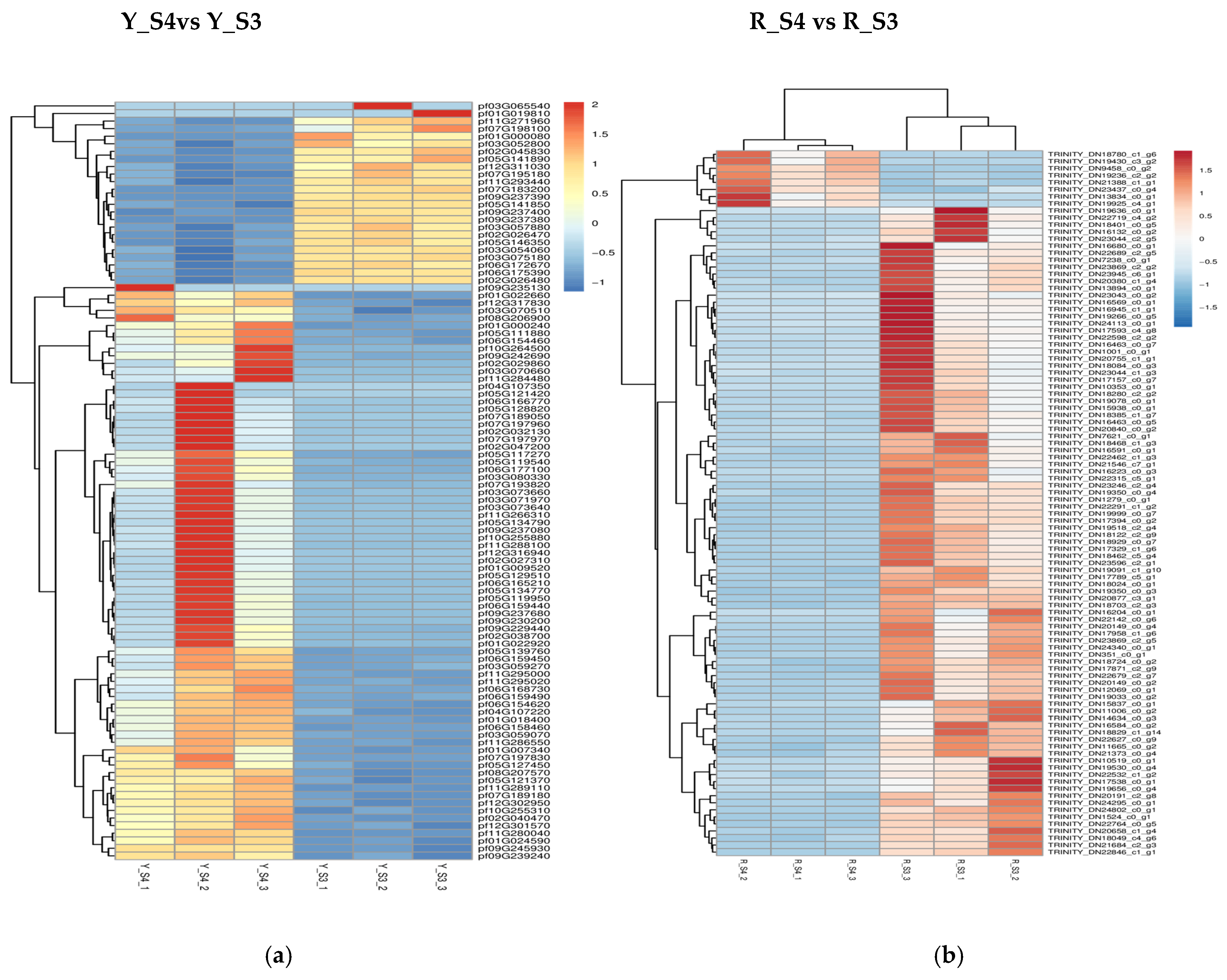Unraveling the Genetic Control of Pigment Accumulation in Physalis Fruits
Abstract
1. Introduction
2. Results
2.1. Fruit Pigment Contents Comparisons
2.1.1. Total Flavonoids Analysis
2.1.2. Total Anthocyanin Analysis
2.1.3. Carotenoid and Chlorophyll Content Analysis
2.1.4. Comparative Analysis of Lutein, β-Carotene, and Lycopene Contents in P. pubescens and P. alkekengi Across Different Fruit Growth Stages
2.2. Transcriptome Analysis of P. pubescens and P. alkekengi Fruits at Different Developmental Stages
2.2.1. Overview of Transcriptomic Data
2.2.2. DEGs Identification
2.2.3. Uncovering the Core Genes in the Carotenoid Biosynthesis Pathway
2.2.4. Key Transcription Factors (TFs) in the Orchestration of Fruit Maturation and Pigmentation
2.2.5. Validation of Transcriptome Sequencing Data through qRT-PCR Analysis
3. Discussion
3.1. Key Genes Driving Fruit Color Variation
3.2. Regulation of Fruit Color by TFs
4. Materials and Methods
4.1. Plant Materials
4.2. Determination of Pigment Contents of Fruits
4.2.1. Quantification of Total Flavonoid Contents
4.2.2. Extraction and Determination of Total Anthocyanin Contents
4.2.3. Measurement of Chlorophyll Contents
4.2.4. Carotenoid Quantification
4.2.5. HPLC-Based Quantification of Lycopene, β-Carotene and Lutein in Fruit Samples
4.3. Transcriptome Sequencing
4.4. Transcriptome Sequencing Validation through qRT-PCR
4.5. Data Analysis
5. Conclusions
Supplementary Materials
Author Contributions
Funding
Institutional Review Board Statement
Informed Consent Statement
Data Availability Statement
Conflicts of Interest
References
- Wen, X.; Erşan, S.; Li, M.; Wang, K.; Steingass, C.B.; Schweiggert, R.M.; Ni, Y.; Carle, R. Physicochemical characteristics and phytochemical profiles of yellow and red Physalis (Physalis alkekengi L. and P. pubescens L.) fruits cultivated in China. Food Res. Int. 2019, 120, 389–398. [Google Scholar] [CrossRef] [PubMed]
- Li, A.L.; Chen, B.J.; Li, G.H.; Zhou, M.X.; Li, Y.R.; Ren, D.M.; Lou, H.X.; Wang, X.N.; Shen, T. Physalis alkekengi L. var. franchetii (Mast.) Makino: An ethnomedical, phytochemical and pharmacological review. J. Ethnopharmacol. 2018, 210, 260–274. [Google Scholar] [CrossRef]
- Whitson, M.; Manos, P.S. Untangling Physalis (Solanaceae) from the Physaloids: A two-gene phylogeny of the Physalinae. Syst. Bot. 2005, 30, 216–230. [Google Scholar] [CrossRef]
- Chen, L.-X.; Xia, G.-Y.; Liu, Q.-Y.; Xie, Y.-Y.; Qiu, F. Chemical constituents from the calyces of Physalis alkekengi var. franchetii. Biochem. Syst. Ecol. 2014, 54, 31–35. [Google Scholar] [CrossRef]
- Zhu, Y.; Jiao, K.; Feng, S.; Wang, H. Efficient cultivation technology regulations for the medicinal and edible plant Physalis pubescens. Zhejiang Agric. Sci. 2018, 59, 957–958. [Google Scholar]
- Zhou, J. A fruit with ornamental, edible, and medicinal uses: Physalis rural. Sci. Technol. Dev. 1995, 5, 39. [Google Scholar]
- González-Pérez, J.E.; Guerrero-Beltrán, J.Á. Tomatillo or husk tomato (Physalis philadelphica and Physalis ixocarpa): A review. Sci. Hortic. 2021, 288, 4. [Google Scholar] [CrossRef]
- Mazova, N.; Popova, V.; Stoyanova, A. Phytochemical composition and biological activity of Physalis spp.: A mini-review. Food Sci. Appl. Biotechnol. 2020, 3, 56–70. [Google Scholar]
- Wu, M.; Xu, X.; Hu, X.; Liu, Y.; Cao, H.; Chan, H.; Gong, Z.; Yuan, Y.; Luo, Y.; Feng, B.; et al. SlMYB72 regulates the metabolism of chlorophylls, carotenoids, and flavonoids in tomato fruit. Plant Physiol. 2020, 183, 854–868. [Google Scholar] [CrossRef]
- Zhao, X.; Zhang, Y.; Long, T.; Wang, S.; Yang, J. Regulation mechanism of plant pigments biosynthesis: Anthocyanins, carotenoids, and betalains. Metabolites 2022, 12, 871. [Google Scholar] [CrossRef]
- Rosas-Saavedra, C.; Stange, C. Biosynthesis of carotenoids in plants: Enzymes and color. Carotenoids Nat. Biosynth. Regul. Funct. 2016, 79, 35–69. [Google Scholar]
- Zhang, L.; Fan, W.J.; Zheng, Z.Y. Research status on the glycosylation, methylation, and acylation modifications of anthocyanins. Mol. Plant Breed. 2022, 7, 299–308. [Google Scholar]
- Henarejos-Escudero, P.; Guadarrama-Flores, B.; Guerrero-Rubio, M.A.; Gómez-Pando, L.R.; García-Carmona, F.; Gandía-Herrero, F. Development of betalain producing callus lines from colored quinoa varieties (Chenopodium quinoa Willd). J. Agric. Food Chem. 2017, 66, 467–474. [Google Scholar] [CrossRef]
- Huang, C.; Zhang, W.; Ren, H.X. Advances in the research of betacyanins in plants. Acta Bot. Boreali-Occident. Sin. 2023, 12, 175–186. [Google Scholar]
- Huang, C.; Ge, C.; Gao, J.; Zhang, X.; Qu, X.; Xu, X. Dynamic changes in the color of the inner pericarp during the development of different types of kiwifruit. J. Nanchang Inst. Technol. 2014, 3, 44–49. [Google Scholar]
- Deli, J.; Matus, Z.; Molnár, P.; Tóth, G. Separation and identification of carotenoids from different coloured paprika (Capsicum annuum) by reversed-phase high-performance liquid chromatography. Eur. Food Res. Technol. 2001, 213, 301–305. [Google Scholar] [CrossRef]
- Lang, Y.Q.; Yanagawa, S.; Sasanuma, T.; Sasakuma, T. Orange fruit color in Capsicum due to deletion of capsanthin-capsorubin synthesis gene. Breed. Sci. 2004, 54, 33–39. [Google Scholar] [CrossRef]
- Deng, M.; Mo, Y.; Lv, J.; Zhao, K.; Huang, Y.; Wang, Y.; Zhang, H. Advances in molecular genetics research on carotenoid biosynthesis in pepper. Guangdong Agric. Sci. 2024, 2, 77–86. [Google Scholar]
- Fantini, E.; Falcone, G.; Frusciante, S.; Giliberto, L.; Giuliano, G. Dissection of tomato lycopene biosynthesis through virus-induced gene silencing. Plant Physiol. 2013, 163, 986–998. [Google Scholar] [CrossRef]
- Mann, V.; Pecker, I.; Hirschberg, J. Cloning and characterization of the gene for phytoene desaturase (Pds) from tomato (Lycopersicon esculentum). Plant Mol. Biol. 1994, 24, 429–434. [Google Scholar] [CrossRef]
- Wen, X.; Heller, A.; Wang, K.; Han, Q.; Ni, Y.; Carle, R.; Schweiggert, R. Carotenogenesis and chromoplast development during ripening of yellow, orange and red colored Physalis fruit. Planta 2020, 251, 95. [Google Scholar] [CrossRef] [PubMed]
- Karniel, U.; Adler Berke, N.; Mann, V.; Hirschberg, J. Perturbations in the carotenoid biosynthesis pathway in tomato fruit reactivate the leaf-specific phytoene synthase 2. Front. Plant Sci. 2022, 13, 844748. [Google Scholar] [CrossRef] [PubMed]
- Parmar, R.; Seth, R.; Sharma, R.K. Genome-wide identification and characterization of functionally relevant microsatellite markers from transcription factor genes of Tea (Camellia sinensis (L.) O. Kuntze). Sci. Rep. 2022, 12, 201. [Google Scholar] [CrossRef]
- Rodrigo, M.J.; Alquézar, B.; Alós, E.; Lado, J.; Zacarías, L. Biochemical bases and molecular regulation of pigmentation in the peel of Citrus fruit. Sci. Hortic. 2013, 163, 46–62. [Google Scholar] [CrossRef]
- Martel, C.; Vrebalov, J.; Tafelmeyer, P.; Giovannoni, J.J. The tomato MADS-box transcription factor RIPENING INHIBITOR interacts with promoters involved in numerous ripening processes in a COLORLESS NONRIPENING-dependent manner. Plant Physiol. 2011, 157, 1568–1579. [Google Scholar] [CrossRef]
- Nawirska-Olszanska, A.; Stepien, B.; Biesiada, A.; Kolniak-Ostek, J.; Oziembloski, M. Rheological, chemical and physical characteristics of golden berry (Physalis peruviana L.) after convective and microwave drying. Foods 2017, 6, 60. [Google Scholar] [CrossRef]
- Wen, X.; Hempel, J.; Schweiggert, R.M.; Ni, Y.; Carle, R. Carotenoids and carotenoid esters of red and yellow Physalis (Physalis alkekengi L. and P. pubescens L.) fruits and calyces. J. Agric. Food Chem. 2017, 65, 6140–6151. [Google Scholar] [CrossRef] [PubMed]
- Chung, S.W.; Yu, D.J.; Lee, H.J. Changes in anthocyanidin and anthocyanin pigments in highbush blueberry (Vaccinium corymbosum cv. Bluecrop) fruits during ripening. Hortic. Environ. Biotechnol. 2016, 57, 424–430. [Google Scholar] [CrossRef]
- Yoo, H.J.; Park, W.J.; Lee, G.M.; Oh, C.S.; Yeam, I.; Won, D.C.; Kim, C.K.; Lee, J.M. Inferring the genetic determinants of fruit colors in tomato by carotenoid profiling. Molecules 2017, 22, 764. [Google Scholar] [CrossRef]
- Shen, Y.H.; Yang, F.Y.; Lu, B.G.; Zhao, W.W.; Jiang, T.; Feng, L.; Chen, X.J.; Ming, R. Exploring the differential mechanisms of carotenoid biosynthesis in the yellow peel and red flesh of papaya. BMC Genom. 2019, 20, 49. [Google Scholar] [CrossRef]
- Blas, A.L.; Ming, R.; Liu, Z.; Veatch, O.J.; Paull, R.E.; Moore, P.H.; Yu, Q. Cloning of the papaya chromoplast-specific lycopene β-cyclase, CpCYC-b, controlling fruit flesh color reveals conserved microsynteny and a recombination hot spot. Plant Physiol. 2010, 152, 2013–2022. [Google Scholar] [CrossRef] [PubMed]
- Xia, H.; Zhou, Y.; Lin, Z.; Guo, Y.; Liu, X.; Wang, T.; Wang, J.; Deng, H.; Lin, L.; Deng, Q.; et al. Characterization and functional validation of β-carotene hydroxylase AcBCH genes in Actinidia chinensis. Hortic. Res. 2022, 9, uhac063. [Google Scholar] [CrossRef] [PubMed]
- Lu, C.F.; Gao, Y.X.; Huang, H.; Dai, S.L. Advances in research on carotenoid metabolism and regulation in plants. Acta Hortic. Sin. 2022, 49, 36–55. [Google Scholar]
- Ampomah-Dwamena, C.; Thrimawithana, A.H.; Dejnoprat, S.; Lewis, D.; Espley, R.V.; Allan, A.C. A kiwifruit (Actinidia deliciosa) R2R3-MYB transcription factor modulates chlorophyll and carotenoid accumulation. New Phytol. 2019, 221, 309–325. [Google Scholar] [CrossRef]
- Obel, H.O.; Cheng, C.; Li, Y.; Tian, Z.; Njogu, M.K.; Li, J.; Lou, Q.; Yu, X.; Yang, Z.; Ogweno, J.O.; et al. Genome-wide identification of the B-box gene family and expression analysis suggests their potential role in photoperiod-mediated β-carotene accumulation in the endocarp of cucumber (Cucumis sativus L.) fruit. Genes 2022, 13, 658. [Google Scholar] [CrossRef]
- Xing, S.; Li, R.; Zhao, H.; Zhai, H.; He, S.; Zhang, H.; Zhou, Y.; Zhao, N.; Gao, S.; Liu, Q. The transcription factor IbNAC29 positively regulates the carotenoid accumulation in sweet potato. Hortic. Res. 2023, 10, uhad010. [Google Scholar] [CrossRef]
- Zhang, J.; Hu, Z.; Yao, Q.; Guo, X.; Nguyen, V.; Li, F.; Chen, G. A tomato MADS-box protein, SlCMB1, regulates ethylene biosynthesis and carotenoid accumulation during fruit ripening. Sci. Rep. 2018, 8, 3413. [Google Scholar] [CrossRef]
- Dang, Q.; Sha, H.; Nie, J.; Wang, Y.; Yuan, Y.; Jia, D. An apple (Malus domestica) AP2/ERF transcription factor modulates carotenoid accumulation. Hortic. Res. 2021, 8, 223. [Google Scholar] [CrossRef]
- Li, S.Y.; Yan, Z.; Niu, G.C.; Wei, W.Y. Study on the determination of total flavonoids content in hairy fruit by spectrophotometry. Food Res. Dev. 2016, 37, 138–143. [Google Scholar]
- Zhao, Y.G.; Cheng, D.Y.; Fan, Y.J.; Liu, Y.H. Determination of total flavonoids content in different medicinal parts of Physalis alkekengi. Shi Zhen Guo Yi Guo Yao 2010, 21, 65–66. [Google Scholar]
- Zhang, Z.; Chen, Z. Plant Physiology Experimental Techniques; Jilin University Press: Changchun, China, 2008; pp. 62–66. [Google Scholar]
- Zhang, Y.; Zhang, L. Determination of total carotenoids in carrots. China Food Nutr. 2006, 6, 25–26. [Google Scholar]
- Arias, R.; Lee, T.C.; Logendra, L.; Janes, H. Correlation of lycopene measured by HPLC with the L*, a*, b* color readings of a hydroponic tomato and the relationship of maturity with color and lycopene content. J. Agric. Food Chem. 2000, 48, 1697–1702. [Google Scholar] [CrossRef] [PubMed]
- Barboza, M.; Lima, F.L.D.S.; Ribeiro, R.M.P.; Pereira, C.C.A.; Santos, M.G.D.; Silveira, F.P.D.M.; Nascimento, A.K.Q.D.; Passos, A.B.R.D.J.; Chagas, P.S.F.D.; Ribeiro, J.E.D.S.; et al. Determination of Total Carotenoids and β-Carotene in Germplasm of Pumpkin Caboclo (Cucurbita maxima). Agronomy 2023, 13, 1109. [Google Scholar] [CrossRef]
- Cheng, X.; Zhao, X.; Huang, C.; Zhang, X.; Lyu, Y. Lutein content in petals and leaves of marigold and analysis of lutein synthesis gene expression. Acta Physiol. Plant. 2019, 41, 128. [Google Scholar] [CrossRef]
- Gao, X.; Tan, G.Y.; Zhu, C.Z.; He, D.G. Genetic diversity analysis of F1 populations in different broccoli varieties. N. Hortic. 2022, 17, 7–14. [Google Scholar]
- Ge, W.; Wang, H.Y.; Liu, M.H.; Zhang, L.C.; Liu, D.Y.; Zhou, B.G.; Zuo, Y.Z. The regulatory effect of curcumin on the miRNA-mRNA expression profile in mice with autoimmune hepatitis. Chin. J. Tradit. Chin. Med. 2022, 5, 141–146. [Google Scholar]
- Kong, W.Q.; Ling, J.; Yang, J.H. Identification of viruses in deformed mulberry leaves and analysis of their small RNA characteristics. Plant Protection. 2022, 5, 255–259+272. [Google Scholar]
- Parkhomchuk, D.; Borodina, T.; Amstislavskiy, V.; Banaru, M.; Hallen, L.; Krobitsch, S.; Lehrach, H.; Soldatov, A. Transcriptome analysis by strand-specific sequencing of complementary DNA. Nucleic Acids Res. 2009, 37, e123. [Google Scholar] [CrossRef]
- Martin, M. Cutadapt removes adapter sequences from high-throughput sequencing reads. Embnet J. 2011, 17, 10. [Google Scholar] [CrossRef]
- Kim, D.; Paggi, J.M.; Park, C.; Bennett, C.; Salzberg, S.L. Graph-based genome alignment and genoty** with HISAT2 and HISAT-genotype. Nat. Biotechnol. 2019, 37, 907–915. [Google Scholar] [CrossRef]
- Pertea, M.; Pertea, G.M.; Antonescu, C.M.; Chang, T.C.; Mendell, J.T.; Salzberg, S.L. StringTie enables improved reconstruction of a transcriptome from RNA-seq reads. Nat. Biotechnol. 2015, 33, 290–295. [Google Scholar] [CrossRef] [PubMed]
- Young, M.D.; Wakefield, M.J.; Smyth, G.K.; Oshlack, A. Gene ontology analysis for RNA-seq: Accounting for selection bias. Genome Biol. 2010, 11, R14. [Google Scholar] [CrossRef] [PubMed]
- Grabherr, M.G.; Haas, B.J.; Yassour, M.; Levin, J.Z.; Thompson, D.A.; Amit, I.; Adiconis, X.; Fan, L.; Raychowdhury, R.; Zeng, Q.; et al. Trinity: Reconstructing a full-length transcriptome without a genome from RNA-Seq data. Nat. Biotechnol. 2011, 29, 644. [Google Scholar] [CrossRef] [PubMed]
- Varet, H.; Brillet-Guéguen, L.; Coppée, J.Y.; Dillies, M.A. SARTools: A DESeq2-and EdgeR-based R pipeline for comprehensive differential analysis of RNA-Seq data. PLoS ONE 2016, 11, e0157022. [Google Scholar] [CrossRef]
- Wang, G.; Guo, Z.; Wang, X.; Guan, S.L.; Gao, H.; Qi, K.; Gu, C.; Zhang, S. Identification and testing of reference genes for qRT-PCR analysis during pear fruit development. Biologia 2022, 77, 2763–2777. [Google Scholar] [CrossRef]
- Zheng, Y.; Ma, Y.; Luo, J.; Li, J.; Zheng, X.; Gong, H.; Deng, L.; Zhao, G.; Luo, C.; Liu, X. Identification and Analysis of Reference and Tissue-Specific Genes in Bitter Gourd Based on Transcriptome Data. Horticulturae 2023, 9, 1262. [Google Scholar] [CrossRef]











| Material | Total Flavone Content (μg/g FW) | |||
|---|---|---|---|---|
| Green Ripening Stage (S1) | Color Conversion Stage (S2) | Firm Ripening Stage (S3) | Full Ripening Stage (S4) | |
| P. Pubescens (Y) | 112.64 c ± 0.02 | 247.42 b ± 0.15 | 333.58 a ± 0.01 | 341.65 a ± 0.11 |
| P. alkekengi (R) | 194.70 c ± 0.03 | 232.53 b ± 0.21 | 279.83 a ± 0.23 | 339.36 a ± 0.02 |
| Material | Anthocyanin Content (nmol/g FW) | |||
|---|---|---|---|---|
| Green Ripening Stage (S1) | Color Conversion Stage(S2) | Firm Ripening Stage (S3) | Full Ripening Stage (S4) | |
| P. pubescens (Y) | 11.03 c ± 0.12 | 21.62 b ± 0.03 | 30.83 a ± 0.06 | 32.75 a ± 0.18 |
| P. alkekengi (R) | 25.98 b ± 0.09 | 33.02 b ± 0.14 | 41.38 ab ± 0.21 | 58.73 a ± 0.04 |
| Material | Carotenoid Content (μg/g FW) | |||
|---|---|---|---|---|
| Green Ripening Stage (S1) | Color Conversion Stage (S2) | Firm Ripening Stage (S3) | Full Ripening Stage (S4) | |
| P.pubescens (Y) | 72.73 c ± 0.04 | 202.28 bc ± 0.02 | 289.25 b ± 0.23 | 360.07 a ± 0.15 |
| P. alkekengi (R) | 175.07 c ± 0.01 | 234.04 b ± 0.01 | 286.16 ab ± 0.03 | 506.81 a ± 0.11 |
| Material | Chlorophyll Content (μg/g FW) | |||
|---|---|---|---|---|
| Green Ripening Stage (S1) | Color Conversion Stage (S2) | Firm Ripening Stage (S3) | Full Ripening Stage (S4) | |
| P.pubescens (Y) | 561.89 a ± 0.12 | 453.81 ab ± 0.01 | 202.36 bc ± 0.21 | 134.33 c ± 0.15 |
| P. alkekengi (R) | 427.87 a ± 0.02 | 246.66 ab ± 0.03 | 111.23 ab ± 0.13 | 34.96 bc ± 0.04 |
| Group | Lutein Content (μg/g FW) | β-Carotenoid Content (μg/g FW) | Lycopene Content (μg/g FW) |
|---|---|---|---|
| green ripening stage (YS1) | 3.2614 a ± 0.01 | 0.4418 b ± 0.11 | 21.8701 a ± 0.13 |
| color conversion stage (YS2) | 0.7463 b ± 0.04 | 0.0320 b ± 0.12 | 6.1324 b ± 0.02 |
| firm ripening stage (YS3) | 0.0172 c ± 0.21 | 9.8345 a ± 0.21 | 4.6272 b ± 0.04 |
| full ripening stage (YS4) | 0.1598 c ± 0.15 | 10.9035 a ± 0.06 | 2.9403 b ± 0.11 |
| Group | Lutein Content (μg/g FW) | β-Carotenoid Content (μg/g FW) | Lycopene Content (μg/g FW) |
|---|---|---|---|
| green ripening stag (RS1) | 0.47 b ± 0.15 | 0.12 c ± 0.04 | 5.67 c ± 0.10 |
| color conversion stage (RS2) | 2.76 a ± 0.01 | 1.79 bc ± 0.13 | 55.67 ab ± 0.09 |
| firm ripening stage (RS3) | 2.43 a ± 0.11 | 10.42 b ± 0.22 | 63.45 a ± 0.04 |
| full ripening stage (RS4) | 2.31 a ± 0.03 | 37.00 a ± 0.11 | 42.85 b ± 0.02 |
| Gene ID | Description | Y_S1 FPKM | Y_S2 FPKM | Y_S3 FPKM | Y_S4 FPKM |
|---|---|---|---|---|---|
| pf01G007760 | Phytoene synthase | 3.47 | 69.59 | 520.66 | 487.31 |
| pf05G128020 | Phytoene synthase 2 | 12.43 | 59.84 | 71.29 | 71.24 |
| pf11G271830 | Phytoene desaturase | 22.15 | 48.57 | 44.07 | 43.95 |
| pf12G307220 | 15-cis-zeta-carotene isomerase | 11.78 | 8.70 | 2.99 | 3.69 |
| pf03G079830 | Zeta-carotene desaturase | 18.47 | 47.10 | 41.42 | 63.49 |
| pf10G251140 | Prolycopene isomerase | 11.08 | 34.50 | 32.84 | 34.04 |
| pf06G178980 | Lycopene beta cyclase | 3.88 | 17.64 | 21.46 | 22.74 |
| pf02G043370 | Beta-carotene hydroxylase 1 | 26.45 | 90.02 | 31.68 | 166.98 |
| Gene ID | Description | Y_S1 FPKM | Y_S2 FPKM | Y_S3 FPKM | Y_S4 FPKM |
|---|---|---|---|---|---|
| TRINITY_DN17898_c1_g1 | Phytoene synthase | 0.07 | 0.58 | 42.23 | 26.61 |
| TRINITY_DN18612_c3_g2 | Bifunctional 15-cis-phytoene synthase | 3.24 | 3.22 | 7.93 | 1.61 |
| TRINITY_DN18164_c0_g3 | Phytoene desaturase | 16.02 | 17.54 | 37.98 | 27.25 |
| TRINITY_DN16907_c0_g4 | Zeta-carotene desaturase | 19.76 | 13.14 | 25.47 | 18.46 |
| TRINITY_DN10183_c0_g1 | Prolycopene isomerase 1 | 0.77 | 0.70 | 1.77 | 1.49 |
| TRINITY_DN23805_c0_g3 | Lycopene epsilon cyclase | 3.97 | 0.74 | 0.78 | 0.09 |
| TRINITY_DN20150_c1_g3 | Lycopene beta cyclase | 4.13 | 2.28 | 8.66 | 6.84 |
| TRINITY_DN21869_c2_g2 | Beta-carotene hydroxylase 1 | 25.92 | 16.63 | 84.30 | 49.81 |
| Gene ID | Description | Y_S1 FPKM | Y_S2 FPKM | Y_S3 FPKM | Y_S4 FPKM |
|---|---|---|---|---|---|
| pf03G061540 | Transcription factor MYB57 | 15.55 | 8.29 | 3.98 | 5.77 |
| pf07G183140 | Transcription factor MYB25 | 6.67 | 2.99 | 1.67 | 1.19 |
| pf08G203960 | Transcription factor MYB48 | 12.86 | 24.11 | 6.67 | 4.47 |
| pf11G282100 | Transcription factor MYB32 | 19.29 | 4.39 | 1.75 | 1.47 |
| pf11G292660 | Transcription factor bHLH66 | 7.14 | 6.28 | 1.81 | 0.63 |
| pf01G004050 | Transcription factor bHLH62 | 19.57 | 13.54 | 6.69 | 6.03 |
| pf03G069270 | Transcription factor bHLH49 | 3.70 | 2.17 | 8.42 | 25.28 |
| pf03G081450 | Transcription factor bHLH13 | 8.17 | 10.36 | 7.87 | 9.29 |
| pf05G146670 | Transcription factor bHLH93 | 18.65 | 13.59 | 4.80 | 4.32 |
| Gene ID | Description | Y_S1 FPKM | Y_S2 FPKM | Y_S3 FPKM | Y_S4 FPKM |
|---|---|---|---|---|---|
| TRINITY_DN18784_c1_g5 | Transcription factor bHLH79 | 16.20 | 13.33 | 5.51 | 3.00 |
| TRINITY_DN11161_c0_g1 | Transcription factor bHLH106 | 0.74 | 1.78 | 0.28 | 0.25 |
| TRINITY_DN19371_c1_g6 | Heat shock factor protein HSF8 | 15.34 | 16.33 | 19.02 | 26.89 |
| TRINITY_DN17987_c4_g1 | WRKY transcription factor 2 | 37.68 | 17.18 | 14.84 | 13.42 |
| TRINITY_DN18956_c1_g8 | WRKY transcription factor 6 | 2.42 | 5.26 | 5.30 | 4.09 |
| TRINITY_DN21261_c0_g2 | MADS-box transcription factor 23 isoform X1 | 40.57 | 35.88 | 11.06 | 12.78 |
| TRINITY_DN21284_c1_g11 | Ethylene-responsive transcription factor RAP2-13 | 3.33 | 9.01 | 3.63 | 0.49 |
| TRINITY_DN19991_c0_g6 | ethylene-responsive transcription factor RAP2-12 | 91.16 | 48.24 | 48.66 | 41.65 |
| TRINITY_DN22588_c3_g4 | NAC1 transcription factor | 1.01 | 0.57 | 2.26 | 0.91 |
| Gene ID | Forward Primer (5′-3′) | Reverse Primer (5′-3′) |
|---|---|---|
| pf05G131930 | GCTTGACTGGGCTGACCTCTTT | CTCTGGTTGTGGACATGGTGGA |
| pf05G143590 | TCGCCTAACGAGAGGTGCTTCA | GATCAATGGCACCACCGCTGTT |
| pf05G124720 | TGTGGCGTCACCCAGAGAATGT | CAGCAGGAGTCACGTTGGCAAT |
| pf02G043870 | TGGCTTGGCTCGAACTCCTCAA | GCATCACGCATGGGTGGGTATC |
| pf02G043370 | TTCCGCCACAGTCCGTTTCTTG | CTACAGCAGCACCAACCGAGAG |
| pf02G027350 | GAGGCTTCTCGCTGAGGTCTCA | GGCTGAGGAGGCGTGACATCTA |
| Pp.GAPDH | TGTGGGTGTCAACGAGAAGGAATAC | ATAAGACCCTCCACAATGCCAAACC |
| Gene ID | Forward Primer(5′-3′) | Reverse Primer(5′-3′) |
|---|---|---|
| TRINITY_DN18251_c1_g2 | TGGTTTGCCCATTAGGCTGT | TGATGGCTGCCTTGAGATCC |
| TRINITY_DN20050_C3_g1 | GTCCACTCACTGCACCTTCA | CGTGAATCTCCACCGTCGAT |
| TRINITY_DN18820_c0_g2 | TCATGAGGGTGCAATGCT | GTTATTGCTCCAGCCAACGC |
| TRINITY_DN18341_C2_g2 | ACTCTGCTTGTGTGGTTGGT | TCCCTCCTCGTCATCCTGTT |
| TRINITY_DN23996_c6_g8 | TCAGCCCATGGAGGAAATCG | CAGGACCAACACCAGAGCTT |
| TRINITY_DN8420_c0_g1 | GCCCTCTCTGGAGCACATAC | GGGCACCTCTCTTGGAGTTC |
Disclaimer/Publisher’s Note: The statements, opinions and data contained in all publications are solely those of the individual author(s) and contributor(s) and not of MDPI and/or the editor(s). MDPI and/or the editor(s) disclaim responsibility for any injury to people or property resulting from any ideas, methods, instructions or products referred to in the content. |
© 2024 by the authors. Licensee MDPI, Basel, Switzerland. This article is an open access article distributed under the terms and conditions of the Creative Commons Attribution (CC BY) license (https://creativecommons.org/licenses/by/4.0/).
Share and Cite
Zhao, W.; Wu, H.; Gao, X.; Cai, H.; Zhang, J.; Zhao, C.; Chen, W.; Qiao, H.; Zhang, J. Unraveling the Genetic Control of Pigment Accumulation in Physalis Fruits. Int. J. Mol. Sci. 2024, 25, 9852. https://doi.org/10.3390/ijms25189852
Zhao W, Wu H, Gao X, Cai H, Zhang J, Zhao C, Chen W, Qiao H, Zhang J. Unraveling the Genetic Control of Pigment Accumulation in Physalis Fruits. International Journal of Molecular Sciences. 2024; 25(18):9852. https://doi.org/10.3390/ijms25189852
Chicago/Turabian StyleZhao, Wennan, Haiyan Wu, Xiaohan Gao, Huimei Cai, Jiahui Zhang, Chunbo Zhao, Weishu Chen, Hongyu Qiao, and Jingying Zhang. 2024. "Unraveling the Genetic Control of Pigment Accumulation in Physalis Fruits" International Journal of Molecular Sciences 25, no. 18: 9852. https://doi.org/10.3390/ijms25189852
APA StyleZhao, W., Wu, H., Gao, X., Cai, H., Zhang, J., Zhao, C., Chen, W., Qiao, H., & Zhang, J. (2024). Unraveling the Genetic Control of Pigment Accumulation in Physalis Fruits. International Journal of Molecular Sciences, 25(18), 9852. https://doi.org/10.3390/ijms25189852





